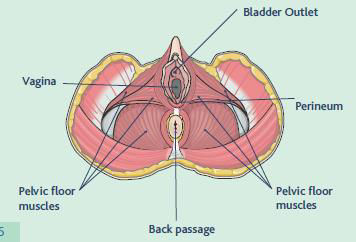Pelvic floor muscles exercises
Exercises for the muscles stretched and weakened by pregnancy and birth
Pelvic floor muscles
Following childbirth, leakages can sometimes occur from the front and/or back passage. This may resolve after a short time. Exercises can help but if the problem persists beyond twelve weeks post-natally, contact your Chartered Physiotherapist in Women’s Health, public health nurse or GP.
What are they?
The pelvic floor forms a broad sling of muscle, lying across the bottom of the pelvis, through which pass the openings from the bowel, vagina (birth passage) and the urethra (passage from the bladder).
They are the main support for the pelvic organs and give control of the three passages.
It is important to make them strong again as weakness of the pelvic floor can cause symptoms such as leakage of urine when coughing, urgent or frequent need to pass urine, leakage of wind and/or stool from the back passage, or decreased satisfaction during intercourse.
You may have some stitches in or near your vagina. The muscles may feel weak and sore, but this exercise will ease the pain and start to strengthen them. Try to start gently within a few hours of the birth.

Pelvic floor exercise
- Imagine that you are trying to stop yourself from passing wind and at the same time trying to stop your flow of urine mid-stream. The feeling is one of ‘squeeze and lift’, closing and drawing up the back and front passages.
- Hold the muscles up whilst breathing.
- Then relax fully and let your pelvic floor lower again.
- Repeat 10 times.
- Always rest for a few seconds before repeating the exercise.
Gentle rhythmical squeezes, in the first 48 hours after childbirth will help ease pain and reduce swelling. These should be done frequently, for 30 seconds at a time.
- Once the pain and discomfort has eased, aim to hold the lift for 3-4 seconds, gradually aiming to increase the hold time to 10 seconds as your muscles become stronger.
- Repeat as many times as you can (up to a maximum of 10 repetitions at a time).
This routine should be practised as often as possible. You should feel your lower tummy (below your tummy button) tightening gently as you do this. However, it is very important to do this exercise without pulling in your whole tummy, squeezing your legs together, tightening your buttocks or holding your breath.
Add some quick strong squeezes to the 10-second hold, remembering to relax completely after each exercise.
Quickly lift and squeeze your pelvic floor muscles prior to laughing, coughing, sneezing or lifting; this will protect the pelvic floor and prevent undue pressure on the muscles. This technique is known as “the knack”. Get into the habit of using “the knack” in all situations where extra pressure is coming on the pelvic floor, including each time you stand up, or lift your baby.
Doing the pelvic floor exercise is like operating an elevator. Initially, you will only be able to take the elevator up to the first few floors, but as you get stronger, you will be able to go right up to the top (tenth) floor. Aim as part of your exercise routine to do some exercises, holding the muscle at the third floor, but aiming to hold for 20 seconds; this will improve your endurance; at other times, take the elevator to the top floor, but hold for 10 seconds. This will improve the muscle strength.
Remember, pelvic floor exercises are for life. Get into the habit of doing these exercises several times a day. They can be done at any time and in any position. If done correctly, no one should know you are doing them, so they can be done while standing in queues, talking on the phone, at meetings, etc! It is a good idea to make them part of your daily routine ie. doing them each time you brush your teeth.
How to know if you are doing your exercises correctly:
- Try to gently slow or stop the flow of urine towards the end of your stream, then relax and finish emptying your bladder. This is a test, and not an exercise. It should not be done more than once a week.
- Gently insert two fingers into your vagina, and try to feel the muscles contract from the back, sides and front.
- When you resume intercourse, try squeezing around your partner’s penis. Your partner will be delighted to give you feedback as to how your strength is improving!
- If in doubt, ask your GP to refer you to a Chartered Physiotherapist in Women’s Health.
Help us provide information most relevant to you
Please ensure your role and areas of interest are up to date.
